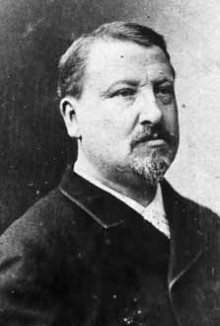Eugène Ducretet
Eugène Adrien Ducretet (born November 27, 1844 in Paris , † 1915 there ) was a French inventor and industrialist.
Early years
His father was a businessman and had planned the same profession for him, but Ducretet showed more interest in technical and scientific processes. At the age of 13 he visited the workshop of the designer Froment, where he learned the basics of mechanics and electricity . At the age of 20 he founded his own workshop, in which he initially manufactured precision instruments for research and industry. Due to the good quality of his products, he gradually supplied the most important physicists of his time at home and abroad.
Highlights of his career
In the further course of his career he applied for numerous patents and developed, for example, a gas liquefier, a device for recording the signals of the optical telegraphs still in operation at the time, and an X-ray machine in 1895, just one month after the discovery of X-rays . He later built illuminated probes and X-ray machines for hospitals. From 1885 he was a Knight of the Legion of Honor .
In November 1897 he made the first attempts with wireless transmissions (French: TSF - Transmission sans fil ) between his workshop in Paris on Rue Claude Bernard and the Panthéon, 400 m away . These experiments were also demonstrated to the President Félix Faure . He caused a sensation when, on November 5, 1898, in front of representatives of the Académie des sciences, he carried out a public demonstration of a wireless communication transmission between the third platform of the Eiffel Tower and the Panthéon, about 4 km away. The Russian Navy then bought its first radios from Ducretet. At the beginning of the 20th century, Ducretet was one of the few manufacturers of radio equipment and accessories that could compete with Guglielmo Marconi, the Italian leader in this field at the time .
Late years and after his death
In 1908, at the age of 64, due to illness, he handed over the management of his company to his son Ferdinand (1888–1928) and his long-time chief engineer Ernest Roger. From then on, the company acted as Ducretet-Roger. His brother Pierre, an infantry officer, died near Verdun in 1915 . In the same year Ducretet died in Paris.
During Ducretet's lifetime, the focus of its products was on the commercial sector. This changed in 1931, when the company was taken over by the group founded by Elihu Thomson and henceforth operated under the name Ducretet-Thomson. From this time onwards, radios and (after the Second World War) television sets and car radios were built in large numbers. The first transistor radios hit the market in 1957 under the name Ducretet-Thomson , including the TR854 portable radio. Later the name Ducretet disappears in the Thomson concern .
literature
- Jean-Claude Montagné: Eugène Ducretet - French pioneer of radio. Montagné, Bagneux 1998, ISBN 2-9505255-3-9 .
Web links
- Constructeurs d'instruments scientifiques pour les établissements publics au XIXe siècle (short biography, French)
- Raconte-moi la radio (short biography, French)
| personal data | |
|---|---|
| SURNAME | Ducretet, Eugène |
| ALTERNATIVE NAMES | Ducretet, Eugène Adrien |
| BRIEF DESCRIPTION | French inventor and industrialist |
| DATE OF BIRTH | November 27, 1844 |
| PLACE OF BIRTH | Paris |
| DATE OF DEATH | 1915 |
| Place of death | Paris |
